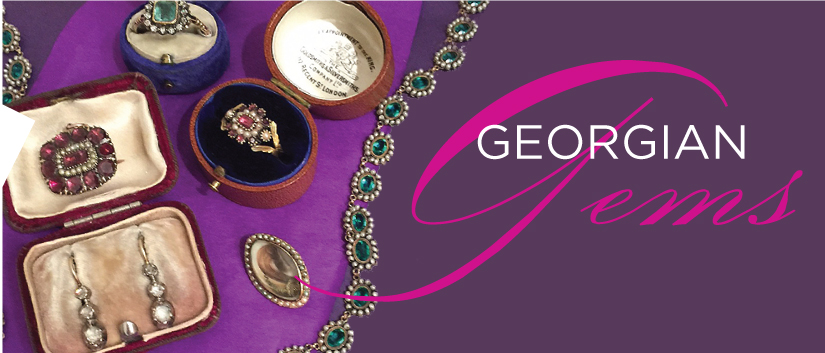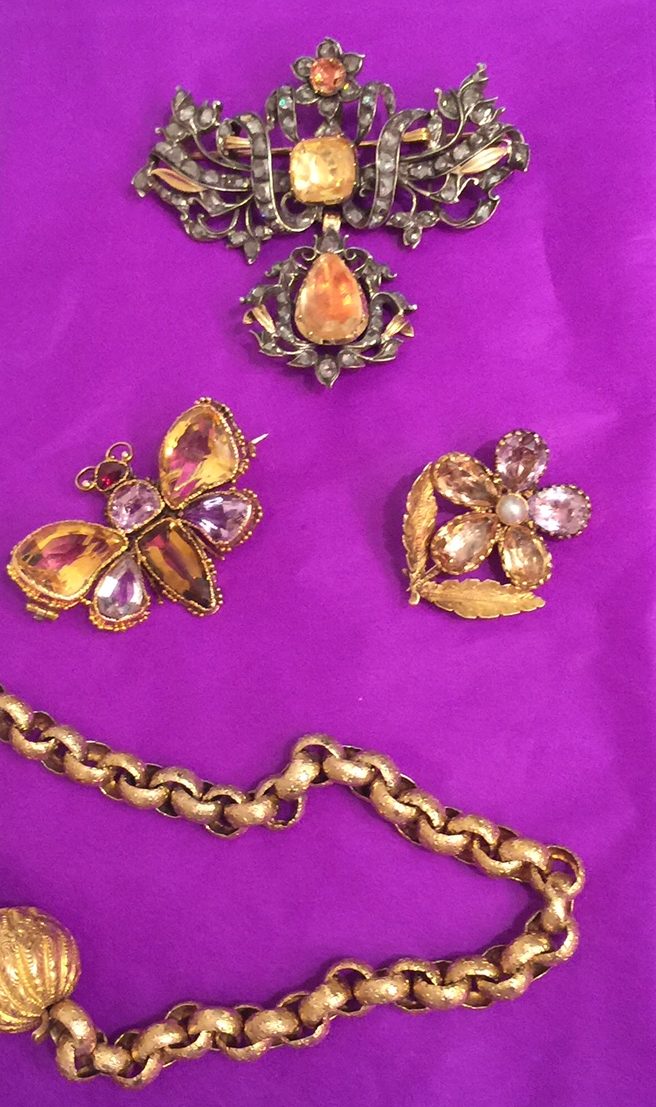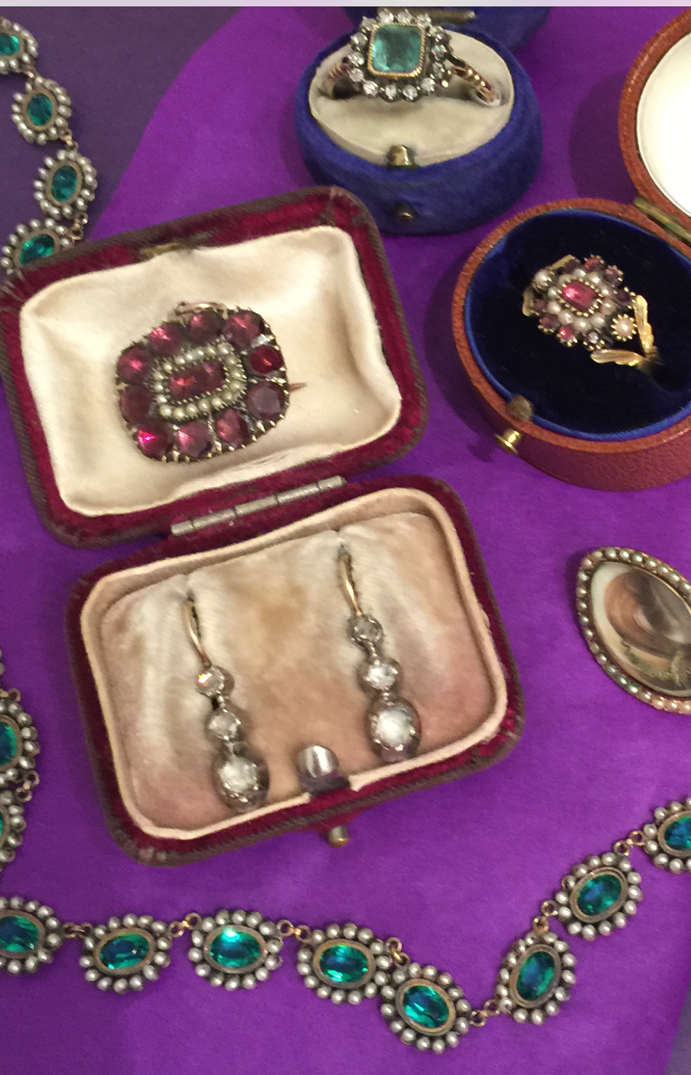Pat Novissimo offers up her expertise on Georgian Jewelry


Georgian topaz pendant, citrine and amethyst butterfly brooch, citrine and amethyst pansy brooch and Georgian chain
It was 18 years ago when I first met U.K.-based Pat Novissimo of Lowther Antiques at a trade fair at the Park Avenue Armory in Manhattan. I went to visit her booth on the introduction of a well-known New York City dealer, for whom I’d been working on the weekends, while writing for magazines and designing jewelry during the week. I took the weekend job to learn hands-on the history of jewelry and had just begun to partake in a bit of trading in antiques myself. Unlike seasoned dealers at the time, when I saw a ring or pair of earrings I loved, I could not pass it up. Raizel Halpen, the dealer for whom I worked, and Pat went back many years before I met them and had similar tastes and an affinity for the same time period: 18th century Georgian jewelry.
I remember the first ring I bought from Pat—there were actually two—a set of Georgian foil-backed flat-cut garnet rings set into 15K gold. They were in excellent condition, she gave me the ‘dealer’ price and even back then I loved stacking. They looked feminine yet powerful surrounding a simple 40s rose gold wedding band.
Times began to change. Prices went up. Shops closed down or changed hands and Raizel passed away. Yet Pat still came over to the States to shows I frequented at least three or four times a year. And each time I saw her, I bought something ‘old.’
I have acquired some exceptional Georgian collectibles from Pat, such as a giardinetti ring (which was my next purchase after the garnet set) a ruby and mine cut diamond witches heart ring, three posy rings with beautiful sayings on the inside, a variety of small earrings, well priced early paste pieces, multiple padlocks and pendants and one ring with a tiny sapphire heart and two crossed swords above it which Pat and I both thought to be magical. It puts a smile on my face and whenever Pat sees me wearing it –she smiles too. I still see Pat four times a year at least, so you can imagine the trouble I can get into.
Pat was in town recently for an antique fair and I jumped at the chance to interview her. There are very few people I would ask for expert advice on buying Georgian jewelry. Pat is at the top of the list. Over dinner outside a noisy neighborhood café with my iPhone recording, Pat let me in on how she started in this business and how she kept it thriving for approximately 40 years.
“My interest in antiques began with my mother-in-law who collected pieces for a proper Victorian lady-from the fan to the gloves and everything in between,” she explains.
After a few years in the business of selling china from the 1820s through1840s, Pat was shopping at Portabello Market and found a Georgian ring of a circle of garnets surrounding a circle of small seed pearls with larger center garnet. She fell in love with it and bought it for herself on the spot. Eventually she switched to selling all jewelry, explaining, “I was pregnant with one of my four children at the time and couldn’t carry big boxes of china around. I also noticed that I favored the same time period in jewelry, predominately 18th century Georgian and some early Victorian,” Pat continues.
“I was completely self-taught. Sure I read a few books when I was starting out and it always helps if you need to look something up. But the way you get into this business and learn is by making mistakes, selling them, then making some more mistakes until you get it right.”
Pat started out in her jewelry venture at the end of the 1970s but turned it into a proper business at the beginning of the 1980s. “Everyone wants to make money and some people buy because they think ‘I can definitely sell this,’ but I could not buy what didn’t appeal or speak to me personally. Over time you develop a feel for what you like and if you are lucky you find customers who have the same taste and want what you are offering.” Pat adds, “That’s how any business develops. I have been very lucky in the U.S. to garner the following I have at shows and in the U.K. during the weekends at Portobello and at various fairs.”
Many of Pat’s pieces that she bought and sold are featured in the definitive book on Georgian Jewellery of the same name by Ginny Dawes with Olivia Collings.
Pat has been instrumental in my learning process and I asked her advice on certain questions that continue to crop up about the earlier pieces:
There are so many reproductions now—can you talk a little about what a dealer and collector can do to spot and steer clear of them?
“Repros are a huge problem as they keep getting better and better. You need to feel and touch the pieces and get a sense of their aura to see if they’re old. My advice is not to purchase online unless it’s a dealer or store you completely trust, have bought from before and will give you a refund if you open the box and it’s not authentic.”
“You need to rely on the dealer/shop who you are purchasing from to know what they are selling and to educate you.
“Repros are most prevalent when demand goes way above the supply. The reproduction artists have gotten so good that sometimes it feels like a minefield even for the dealer going out to buy. But there are certain things to look out for:
-There are way too many lover’s eyes now. There weren’t that many made so err on the side of caution when looking at these, especially if you have no idea what you are looking for.
-You can almost always tell a copy of a Georgian chain. Those made in the 18th century were by hand and ultra light. Stay away from any that feel too heavy. In some later jewelry you want the gold weight. In Georgian chains you don’t.
-For new collectors, it’s almost impossible to figure out if diamond rings that are supposed to be Georgian really are. It takes experience, a good gut and a strong eye to be able to tell the difference, so please buy from a reputable source.
Are Georgian pieces price prohibitive to the novice collector?
“It doesn’t have to be expensive to be a good Georgian piece. If you can’t afford the rose cut or old mine cut diamonds, then invest in an early paste pair of earrings or necklace or 18th century pieces made from cut steel.”
How do you feel about Georgian diamond rings as engagement rings?
“I probably lose a lot of business telling customers this, but if you want to buy an engagement ring, you probably need to go somewhere else. Georgian rings have foiled closed backs, which when immersed in water get very dull due to the fact that the foil gets wet and no longer serves the purpose of giving old cut diamonds more life. My advice is get your everyday engagement ring from someone else and if you want a beautiful example of a Georgian ring to wear on occasion come back to me.”
“I also advise that while out, take off your Georgian rings to wash your hands but hold them by the shank in your mouth. This way you never leave them on some countertop.”
Pat offers her recommendations on starting to build a Georgian jewelry collection and the first five piece you might want to treasure hunt for first:

Emerald colored past necklace, garnet and hair lace pins, two emerald and mine cut diamond Georgian ring, Garnet and seed pearl Georgian ring, double drop Georgian diamond earrings
1- The pretty accessibly priced garnet or gemstone ring, similar to the ring Pat described as her first ring. Pat suggests this as your first ring from this period as a way to get used to taking it off to wash your hands and also to ensure that you are more careful with it than you would be with jewelry of later periods.
2-The Lace pin—they are small and feminine and can ease you into wearing brooches again as one singular piece or in scattered groups of small pins. “These can be flat-cut garnets or amethysts with seed pearls surrounding them or they can be memorial pins with woven hair in the center. Pat explains, “the hair is not always associated with mourning jewelry, often it was worn as a keepsake by a mother who was away from her child for a time and cut a lock of hair to carry close to her heart as a keepsake.
3- A Georgian Paste Necklace. It could be foiled back with a color or white to imitate diamonds of the day but it is an affordable and collectible alternative to diamond or gemstone necklaces of a similar design.
4- A pair of Georgian diamond earrings. A single or double drop that you can wear easily and every day for a bit of subdued sparkle around the face..
5-Short Georgian chain. The longer ones at 56 or 60 inches are price prohibitive for the collector just starting out, but there are beautiful links in the shorter Georgian styles so you might think of investing in one of these first




